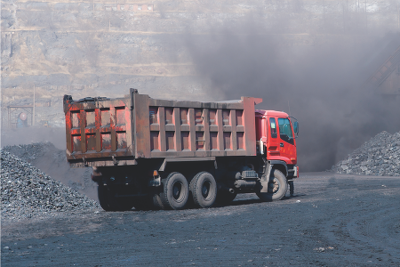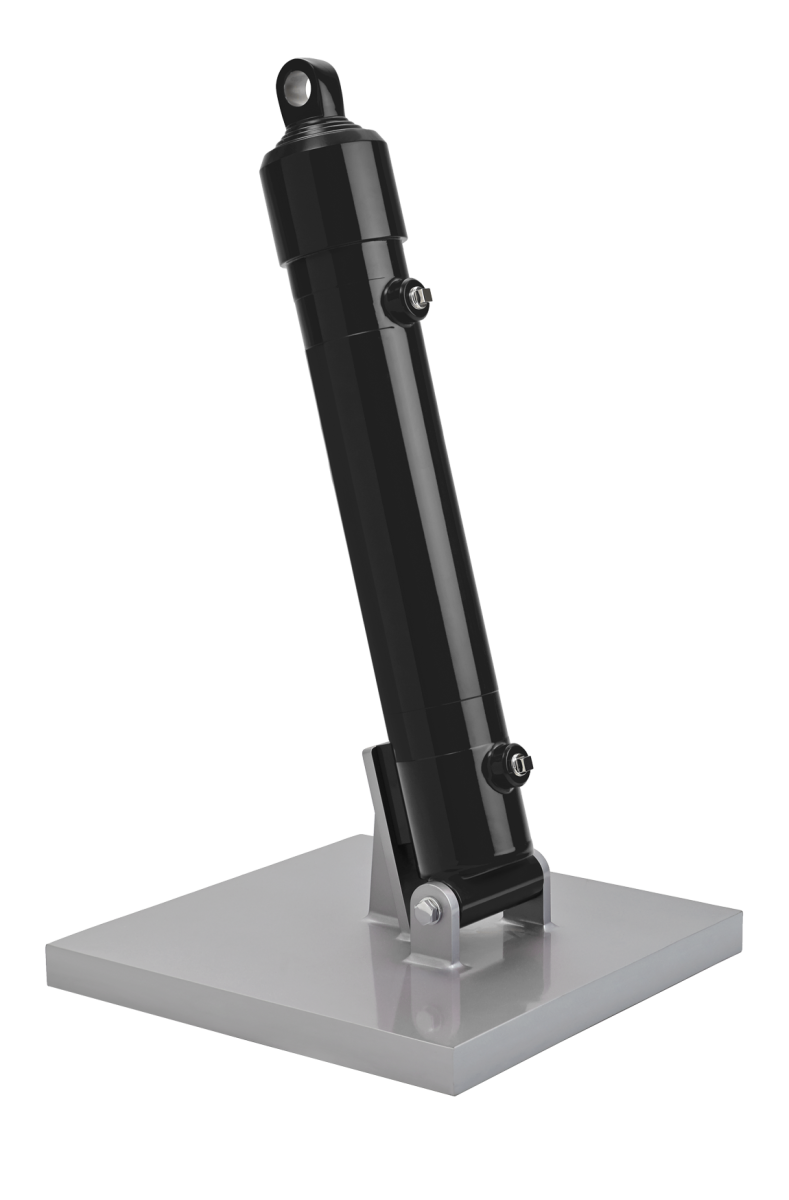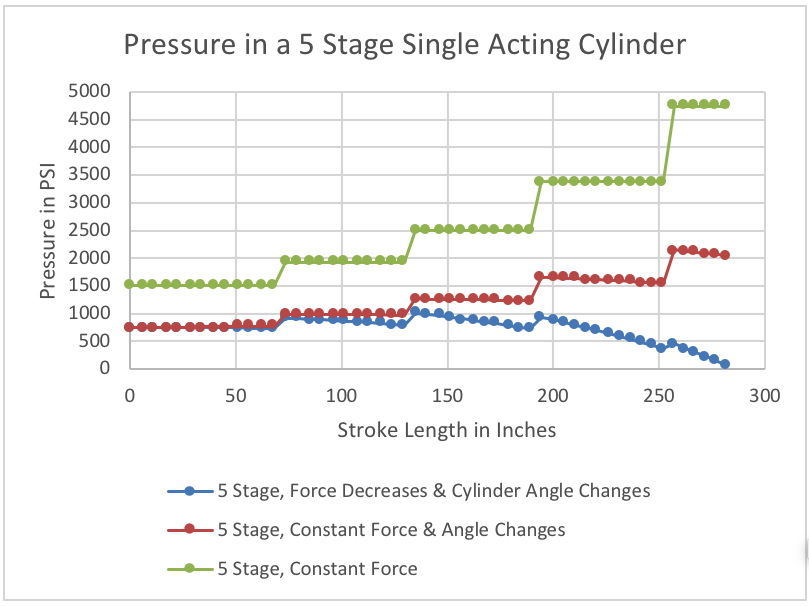Telescopic Hydraulic Cylinder Applications and Pressures
A telescopic hydraulic cylinder can be used in several types of applications that require a linear force to be applied over a long distance. While a rod cylinder could potentially perform the job it may be too long when fully collapsed, whereas a telescopic cylinder will typically be significantly shorter when in the same position. The collapsed package size plus long stroke capability of a telescopic cylinder is one of the advantages the design offers over a rod cylinder.
Rod cylinders will apply the same force throughout their stroke, assuming that system pressure remains constant. While it is possible to design a telescopic cylinder that applies a constant force, the cost is significantly increased. Generally, a telescopic cylinder will be used in applications where a constant force is not required. Both single-acting and double-acting telescopic cylinders are used in non-constant force applications. The most common of these in mobile applications are dump trucks and refuse vehicles.
 In a typical dump truck or trailer application a single-acting telescopic cylinder will be used; however, it is possible to see double-acting cylinders in dump truck or trailer applications. Double-acting telescopic cylinders are most commonly used in applications that require a horizontal, or near horizontal, force to be applied. Refuse pack or eject vehicles and various ejector trailers are typical applications for the double acting cylinder.
In a typical dump truck or trailer application a single-acting telescopic cylinder will be used; however, it is possible to see double-acting cylinders in dump truck or trailer applications. Double-acting telescopic cylinders are most commonly used in applications that require a horizontal, or near horizontal, force to be applied. Refuse pack or eject vehicles and various ejector trailers are typical applications for the double acting cylinder.
The reason for the different cylinder use per application is due to the ability or restriction on being able to retract the extended cylinder. In a typical dump application, the truck or trailer body will be lifted into the air by the cylinder and the weight of the body will cause the cylinder to retract. In some cases, the body of the truck or trailer may go "over center," meaning that the body of the vehicle is now pulling on the cylinder once fully extended. In this type of scenario, a single-stage double-acting or a fully double-acting cylinder is required to, at minimum, pull the body back far enough to allow gravity to take over. Horizontal, or near horizontal applications, do not have gravity available to assist in the retracting of the cylinder. As a result, an internal hydraulically created force is required. Overhung loads, such as a heavy tailgate or several feet of the body extending past the body hinge, can also create scenarios that require a double-acting cylinder.
At the most simplified level, all cylinders generate force and motion in the same way. A fluid is forced into the vessel and it pushes against a movable surface. The available surface area within the cylinder determines the amount of force generated at a given pressure. Interestingly, the pressure is truly the consequence of applying a force.
For example, the weight of a dump body plus the material in it creates a load that requires a specific force to be applied in order to move or dump the material. As oil is supplied to the cylinder, pressure builds in an attempt to move the stages. If the available surface area is large, the resulting pressure required to move the load will be low. Contrary to this, if the available surface area is small, a higher pressure will be required to move the load. This same principle applies to both single-acting and double-acting cylinders. Both single and double-acting cylinders will require some level of pressure to build in order to generate enough force to overcome the load that is opposing them.
The pressure must also build to a high enough level within a double-acting cylinder to allow it to retract; however, the pressures required to retract a telescopic cylinder can be much higher than the pressures required to extend—that is if the same forces are required to extend and retract.
 Several things can limit the force applied by a cylinder. A few of the key limiting factors to consider are the size and resulting surface areas available within the cylinder, the materials of the cylinder, the cylinder construction/design, and the pressure limitations of the hydraulic system. Each potential limitation can be tied to one another.
Several things can limit the force applied by a cylinder. A few of the key limiting factors to consider are the size and resulting surface areas available within the cylinder, the materials of the cylinder, the cylinder construction/design, and the pressure limitations of the hydraulic system. Each potential limitation can be tied to one another.
For example, if the system pressure is limited to 2000 PSI and the largest diameter available in the telescopic cylinder is 7", the cylinder will only be able to produce a maximum force of 38.5 tons. If the system is capable of 2500 PSI, the same 7" diameter stage can now produce 48.1 tons of force.
Material selection and construction or design of the cylinder will only limit the maximum pressure and force that the cylinder can handle. In some cases the system pressure limit may be a result of the maximum pressure rating of the cylinder; in other cases, the cylinder maximum rating is greater than the system maximum.
Correctly sizing the cylinder for the application is key based on the maximum force needed and the available maximum system pressure. Telescopic cylinders present an additional challenge when considering the force required. The changing diameters from the cylinder extending and retracting result in a change in the required pressure, as the various stages are moving.
Another challenge can be factoring in a changing load like with a dump truck that gets lighter as the material leaves the body or with a trailer or refuse vehicle as the material is ejected. If the force is to remain constant, the pressure will increase as each smaller stage begins to move (See the green line in Figure 1). An example of this would be an elevator where the force applied to the cylinder is the same during its entire extension, as long as the number of riders remains constant.
A typical dump trailer application will be different because the force needed to move the body will decrease as the cylinder is being extended. This is because the dump angle is increasing and material is leaving the dump body. In this case, the stages are decreasing and the load is decreasing throughout the stroke of the cylinder (See the blue line in Figure 1 as an example).
In the case of a dump trailer with a stuck load, the pressure will increase in a similar manner to that of a constant force; however, in this scenario, the dump angle is still increasing as well. As the dump angle increases during the extension of the cylinder, less weight is applied to the cylinder while more weight shifts to the rear hinge (See the red line in Figure 1 for this situation). Note: All examples are calculated with theoretical conditions using a 5-stage cylinder. The pressures will be significantly different using a different cylinder.

Figure 1
During the typical operation of a dump truck, the initial pressure to start raising the truck body or trailer should never exceed 600–800 PSI. This is because the pressure typically increases within the cylinder and hydraulic system as the cylinder extends (See the blue line in Figure 1). Additionally, if material does become stuck in the dump body/trailer system pressure will continue to increase throughout the entire stroke (See the red line in Figure 1).
Applications that are horizontal, or near horizontal, will have pressure signatures similar in nature to those noted in Figure 1. The defining factor in the pressure signature is the force that is pushing against the cylinder. If it is a constant force, the pressure will steadily increase like the red and green lines. If the force is reduced during the extension of the cylinder, the pressure will follow closer to the blue line.
Next, the geometry of the structure or vehicle using the cylinder will affect the forces and therefore, the pressures required to extend the cylinder. In the case of a dump truck/trailer, the distance between where the cylinder is mounted and where the dump hinge is located can affect performance.
For instance, if there is a large over-hung load past the dump hinge a lower force is required to extend the cylinder. A double-acting cylinder is often required to retract the cylinder in the case of an over-hung load. Changing the mounting points and hinge location of a dump truck/trailer can increase or decrease the force and pressure needed to move the body.
Pressure intensification and back pressure are other factors that should be considered when using a cylinder. First, back pressure can be created while a single-acting cylinder is retracting. If the weight or force pushing on the cylinder is large it will cause the cylinder to collapse quickly. Since the volume of oil can be quite large and in some cases result in an estimated flow rate of 120 GPM, a large amount of back pressure can be created. In cases like this, it is best to have a high-flow dump valve plumbed into the circuit to prevent damage to the cylinder or other system components.
In double-acting cylinders, both telescopic and rod, pressure intensification can occur. As the double-acting cylinder extends, it forces oil out of the retract port. This retract side of the cylinder is normally significantly smaller than the extend side so during extension there is generally no issue; however, during retract the flow of oil to the retract side of the cylinder can be equal to the flow that had been used to originally extend the cylinder.
For example, if the cylinder is extended using 20 GPM it will typically use the same 20 GPM to retract; however, since the retract side of a double-acting cylinder requires less oil—a lower volume—the speed of the cylinder during retraction can be quite fast. A cylinder with a 7:1 ratio—where the extended side is 7 times larger than its retract side—can have a pressure intensification issue.
Sticking with the 7:1 ratio, a cylinder that takes 35 gallons to extend and five gallons to retract will have a cycle time of 2 minutes—1 minute, 45 seconds, for extension and 15 seconds to retract. This means that the flow rate of oil leaving the cylinder is 140 GPM. At this high flow rate, there will be a lot of back pressure that can damage the cylinder or the system.
To help protect the system and cylinder a "downside" relief valve is normally installed. This relief valve is utilized on the retract side of the cylinder, limiting the force that can be created during retraction.
There are numerous applications that use cylinders—specifically those that require telescopic cylinders. Each one may present unique challenges beyond those that apply to the applications covered; however, the general concept remains the same. Pressure is a result of the force generated/required to perform the job.


